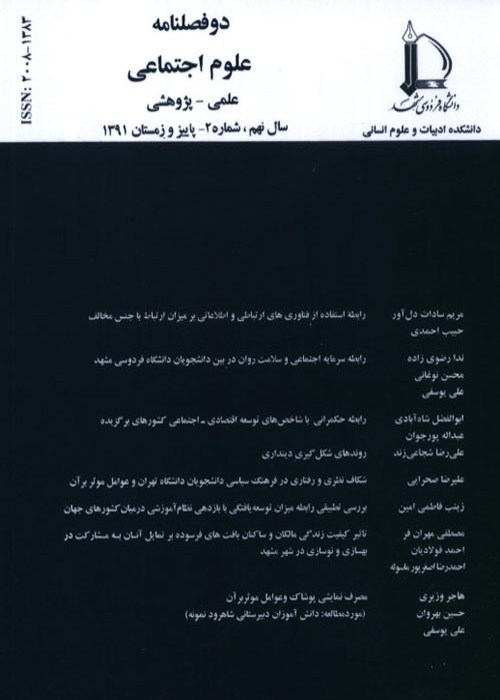Fuzzy Analysis Versus Regression Analysis Superficial and Inappropriate Applications of Fuzzy Analysis in Iran
Author(s):
Abstract:
Introduction
In recent years, fuzzy analysis, as a new methodology, has drawn attentions in the realm of Iranian sociology and has been used by some researchers. Nevertheless, there are some important weaknesses found in the works of Iranian sociologists when they use this new methodology. Bing aware of these weaknesses prevent them form being repeated. Hence, other researchers would take the right track in the future.In the current study, the researcher has attempted to explain these superficial and inappropriate applications. To achieve such aim, fuzzy analysis should be clearly distinguished from the existing analytical methods in Social Sciences, especially regression analysis.
Why fuzzy analysis?: When encountering a new methodology, first it should be asked what problems exist that the previous methodologies could not solve them, and what the new method aims to solve. In other words, the usefulness of fuzzy analysis for social research should be investigated. Moreover, fuzzy analysis, as a new methodology, should practically show that it has the potential to result in achievements which were previously not possible with the existing methodologies. Being concious about the fact that fuzzy analysis is different from the other common analytical methodologies in Social Sciences, especially regression analysis, is necessary for appropriately understanding and applying this method.
Fuzzy analysis VS regression analysis: A long-standing problem which researchers faced in the field of Social Sciences was a gap between the theoretical and empirical levels. On the one side, the content of many theories and theoretical explanations were based on claims about neccessity and sufficiency conditions. On the other side, there was no method or technique for authenticating, empirically verifying or testing these causal hypotheses. If we consider statistics as the dominant mehtod for testing hypotheses in Social Sciences, there was not any statistical book which reffered to necessity and sufficiency hypotheses and how to test them. In order to solve this problem, some methodologists in Social Sciences discussed the necessary and sufficient conditions and techniques for emperically discovering and assessing them. Therefore, they brought this domain into the research methodologies of Social Sciences. In fact, the analysis of fuzzy sets has been presented in order to solve the problem of empirically discovering and assessing theoretical claims including the causal relations of necessary condition, sufficient condition, INUS causality and equifinality. The main achievement of fuzzy analysis methodology was filling the longstanding gap between the theoretical and empirical levels. It seemed that common statistical methodologies including regression analysis and other existing techniques in Social Sciences were uncapable of filling this gap.
In fact, fuzzy analysis and regression analysis are distinguished tools for different objectives. The goal of regression analysis is to separate and estimate the net effects of a causal variable on a dependant variable when the competition among causal variables represents the competitors explanations about the dependant variable. Fuzzy analysts do not consider the main aim of analysis to be seperating and estimating the pure and dependant effects of each of the causal variables on a dependant variable, since such estimations often have certain presumptions such as symmetrical relations, causal congruence and cumulativeness. Rather, fuzzy analysis aims at detecting different combinations of various causal conditions which are related to a consequence or a dependant variable. The aim of fuzzy analysis in Social Sciences is to conduct the set analysis for INUS causality and multiple causal paths. These aims are in conflict with the objectives of regular statistical models in Social Sciences, especially regression analysis.
Differences in the results of Hypothesis Testing: In the last part of the article, the differences between hypothesis test results conducted by fuzzy analysis and regression analysis are mentioned by giving some examples to demonstrate that the empirical evidences or data fitting for linear functions of conventional regression models cannot be a suitable assessment for hypotheses of set relations (necessary and/or sufficient condition). In other words, empirical data proved that functional analysis of the type of linear regression analysis is not suitable for set analysis or fuzzy analysis. The main reason is that two variables or the fuzzy scores of two sets may have a high covariance, but none of them is the sub-set of the other (neseccary or sufficient cause).
Conclusion
Applying statistical analyses of the regression analysis type in studies which have hypotheses based on assymetric relations of neseccary condition or sufficient condition type is not appropriate. Also, using fuzzy analysis for studies which have hypotheses based on functional symmetric relations is not appropriate. Therefore, having concern for the phasing of common variables in Social Sciences without considering the main objectives of fuzzy analysis results in superficial and inappropriate applications of this new methodology.Keywords:
Language:
Persian
Published:
Journal of Social Sciences, Volume:12 Issue: 2, 2016
Pages:
197 to 220
magiran.com/p1563533
دانلود و مطالعه متن این مقاله با یکی از روشهای زیر امکان پذیر است:
اشتراک شخصی
با عضویت و پرداخت آنلاین حق اشتراک یکساله به مبلغ 1,390,000ريال میتوانید 70 عنوان مطلب دانلود کنید!
اشتراک سازمانی
به کتابخانه دانشگاه یا محل کار خود پیشنهاد کنید تا اشتراک سازمانی این پایگاه را برای دسترسی نامحدود همه کاربران به متن مطالب تهیه نمایند!
توجه!
- حق عضویت دریافتی صرف حمایت از نشریات عضو و نگهداری، تکمیل و توسعه مگیران میشود.
- پرداخت حق اشتراک و دانلود مقالات اجازه بازنشر آن در سایر رسانههای چاپی و دیجیتال را به کاربر نمیدهد.
In order to view content subscription is required
Personal subscription
Subscribe magiran.com for 70 € euros via PayPal and download 70 articles during a year.
Organization subscription
Please contact us to subscribe your university or library for unlimited access!


